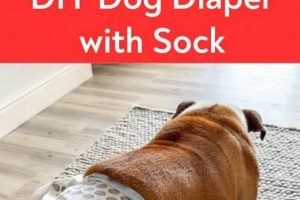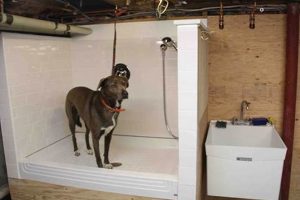The practice of creating homemade solutions for canine aural hygiene refers to the formulation and application of cleaning agents prepared from readily available ingredients. This approach contrasts with commercially manufactured ear cleaning products intended for the same purpose. An example involves combining diluted white vinegar and distilled water for gentle ear canal cleansing.
Maintaining proper ear hygiene is crucial for preventing infections and discomfort in canines. Regular cleaning helps remove wax buildup, debris, and potential irritants that can lead to otitis externa, a common ailment in dogs. Historically, pet owners have sought cost-effective and natural alternatives to address their animals’ health and wellness needs, leading to the exploration of do-it-yourself remedies.
The subsequent discussion will address appropriate ingredient selection, formulation guidelines, application techniques, and safety considerations when considering a homemade approach to canine ear cleaning. This will provide a balanced perspective on the viability and responsible implementation of such practices.
DIY Ear Wash for Dogs
Effective and safe at-home ear cleaning requires careful attention to detail and adherence to established guidelines. The following recommendations aim to provide practical advice for those considering this approach.
Tip 1: Ingredient Dilution is Crucial: Always dilute cleaning solutions, especially if using vinegar or hydrogen peroxide. A commonly recommended ratio is 1:1 with distilled water to minimize irritation of the sensitive ear canal.
Tip 2: Opt for Gentle Ingredients: Avoid harsh chemicals or fragrances that can cause allergic reactions or inflammation. Consider using natural ingredients like witch hazel or diluted green tea, known for their antiseptic properties.
Tip 3: Temperature Matters: Ensure the cleaning solution is at room temperature before application. Cold solutions can cause discomfort and potential dizziness for the animal.
Tip 4: Proper Application Technique: Use a soft cotton ball or gauze pad to gently wipe the outer ear and just inside the ear canal opening. Avoid inserting anything deep into the ear canal to prevent injury.
Tip 5: Drying the Ear is Essential: After cleaning, gently dry the ear canal with a clean cotton ball or gauze pad. Moisture left in the ear can create a breeding ground for bacteria and yeast.
Tip 6: Observe for Adverse Reactions: Monitor the dog for any signs of irritation, such as redness, scratching, head shaking, or discharge. Discontinue use and consult a veterinarian if any of these symptoms occur.
Tip 7: Frequency of Cleaning: Limit ear cleaning to once or twice a month, unless otherwise directed by a veterinarian. Over-cleaning can strip the ear canal of its natural protective oils.
Following these guidelines can contribute to a safer and more effective experience when implementing a homemade ear cleaning regimen. Prioritizing gentle ingredients, proper dilution, and careful application is paramount.
The subsequent section will address potential risks and contraindications associated with at-home ear cleaning, emphasizing the importance of veterinary consultation.
1. Solution Dilution
Solution dilution represents a foundational element in the responsible execution of a homemade ear cleaning regimen for canines. The concentration of the active ingredients directly influences the potential for both therapeutic benefit and adverse reactions. Precise and accurate dilution is therefore not merely a procedural step, but a critical determinant of safety and efficacy.
- Minimizing Irritation
Undiluted or improperly diluted solutions, particularly those containing acidic components like vinegar or astringents such as witch hazel, can induce significant irritation of the sensitive epithelium lining the canine ear canal. This irritation can manifest as redness, pruritus, and, in severe cases, inflammation, potentially exacerbating existing conditions or predisposing the animal to secondary infections.
- Maintaining pH Balance
The canine ear canal maintains a delicate pH balance. Drastic alterations in pH, which can result from overly concentrated solutions, disrupt the natural microflora and create an environment conducive to the proliferation of pathogenic bacteria or yeast. Appropriate dilution helps to maintain a physiological pH range, supporting the ear’s natural defense mechanisms.
- Preventing Chemical Burns
Certain chemicals, even at relatively low concentrations, can cause chemical burns if applied undiluted to delicate tissues. Hydrogen peroxide, a common ingredient in some homemade ear cleaning formulations, is a prime example. Dilution to a concentration of 3% or less is generally recommended to mitigate this risk. Concentrated solutions should be avoided.
- Ensuring Even Distribution
Proper dilution not only reduces the risk of adverse reactions but also facilitates even distribution of the active ingredients throughout the ear canal. Concentrated solutions may pool in certain areas, leading to localized irritation, while diluted solutions are more likely to spread uniformly, ensuring more consistent cleaning and therapeutic effects.
Given the potential risks associated with improper solution dilution, adherence to established guidelines and veterinary recommendations is paramount. Dilution protocols should be followed meticulously, and alternative cleaning methods considered if uncertainty exists regarding the appropriate concentration of a given ingredient. In all cases, erring on the side of caution is advisable to safeguard canine aural health. Dilution also is critical to avoiding serious harm to dogs such as deafness or chemical burns.
2. Ingredient Safety
The formulation of homemade ear cleaning solutions for canines necessitates a thorough evaluation of ingredient safety. The delicate nature of the canine ear canal, coupled with the potential for idiosyncratic reactions, demands a cautious approach to selecting and utilizing any substance introduced into this region. The absence of stringent regulatory oversight for do-it-yourself remedies places the onus of ensuring safety squarely on the pet owner. Failure to prioritize ingredient safety can result in a spectrum of adverse effects, ranging from mild irritation to severe chemical burns and even permanent hearing damage. For instance, the use of tea tree oil, while touted for its antiseptic properties, can be toxic to dogs, causing neurological symptoms and skin irritation even in diluted forms. Similarly, certain essential oils, even when considered safe for humans, may pose significant risks to canines due to differences in metabolic pathways and increased sensitivity.
The choice of base solution is equally crucial. Isopropyl alcohol, a common household antiseptic, can be overly drying and irritating to the ear canal, disrupting the natural protective barrier and predisposing the animal to secondary infections. While diluted white vinegar is often recommended, its acidic nature may exacerbate existing inflammation or cause discomfort in dogs with sensitive skin. A safer alternative is often considered to be sterile saline solution, which closely mimics the natural physiological environment of the ear canal and minimizes the risk of adverse reactions. Furthermore, the presence of impurities or contaminants in even seemingly innocuous ingredients, such as tap water, can introduce harmful microorganisms or irritants into the ear, negating any potential benefits of the cleaning process. Therefore, the selection of high-quality, purified ingredients is paramount. Pet owners should be aware of the potential for cross-reactivity with existing allergies or sensitivities.
In summary, ingredient safety constitutes a non-negotiable aspect of preparing homemade ear cleaning solutions for dogs. The potential for harm necessitates a diligent approach to ingredient selection, prioritizing gentle, non-toxic substances known to be well-tolerated by canines. A comprehensive understanding of potential risks, combined with a commitment to using only the purest and safest ingredients, is essential to protecting the animal’s health and well-being. Consulting with a veterinarian is highly recommended to ensure the chosen ingredients are appropriate for the individual animal’s needs and medical history, minimizing the risk of adverse reactions and maximizing the potential for a positive outcome.
3. Application Method
The application method significantly influences the efficacy and safety of homemade ear cleaning solutions for canines. Improper technique can negate the benefits of even the most carefully formulated solution and potentially cause harm. The connection is direct: an ill-advised method introduces cleaning agents incorrectly, possibly causing injury or infection, while a proper one maximizes cleaning efficacy and reduces risks. For example, forceful insertion of a cotton swab deep into the ear canal, a common mistake, can impact the eardrum or pack debris further inward, leading to inflammation or even rupture. Conversely, a gentle flushing action with a bulb syringe, followed by external wiping, can effectively remove wax and debris without undue trauma, providing relief from irritation and preventing infection. The appropriate method constitutes an essential component of a successful at-home ear cleaning protocol.
Practical application hinges on understanding canine anatomy and recognizing signs of discomfort. A dog exhibiting resistance to ear handling suggests existing sensitivity or pain, warranting a more cautious approach or veterinary consultation. The chosen method should prioritize gentle manipulation and controlled delivery of the solution. A recommended technique involves saturating a cotton ball with the cleaning solution and gently wiping the accessible portions of the ear canal. Direct instillation of fluid into the ear should be performed with caution, angling the nozzle to avoid direct pressure on the eardrum. Following application, gentle massage of the base of the ear can aid in loosening debris before thorough drying with a clean, soft cloth or cotton ball is essential.
In summary, the application method is inextricably linked to the success and safety of at-home ear cleaning for canines. A meticulous and gentle approach, informed by an understanding of canine anatomy and sensitivity, is paramount. While formulating the solution is important, without a correct and caring application, the risks of infection, irritation, or physical damage increase. The correct technique ensures the solution cleans efficiently and effectively. Veterinary consultation remains invaluable, especially for individuals unfamiliar with proper ear cleaning techniques or for dogs with pre-existing ear conditions. Only use the application that has no risks.
4. Drying Procedure
The drying procedure forms an indispensable component of any at-home canine ear cleaning regimen. The very act of washing, irrespective of the solution employed, introduces moisture into the ear canal, creating a microenvironment conducive to the proliferation of bacteria and yeast. Inadequate drying directly elevates the risk of otitis externa, a common inflammatory condition of the outer ear. The correlation constitutes a direct cause-and-effect relationship: washing introduces moisture; insufficient drying fosters microbial growth; microbial proliferation leads to inflammation and infection.
The practical significance of thorough drying manifests in numerous ways. The canine ear canal, unlike that of humans, possesses a more tortuous and less ventilated structure, naturally predisposing it to moisture retention. Residual moisture, combined with warmth and available nutrients, transforms the ear canal into an ideal incubator for opportunistic pathogens. For instance, Malassezia pachydermatis, a common yeast species, thrives in moist environments, frequently causing intensely pruritic and malodorous ear infections. Similarly, Pseudomonas aeruginosa, a bacterium known for its antibiotic resistance, proliferates in such conditions, leading to chronic and difficult-to-treat infections. Effective drying, therefore, represents a proactive measure to disrupt this chain of events, mitigating the risk of infection and preserving ear health.
In conclusion, the drying procedure is not merely an ancillary step but a critical determinant of the success or failure of at-home canine ear cleaning. It serves as a bulwark against opportunistic infections, safeguarding ear health and minimizing the need for costly and potentially invasive veterinary interventions. Challenges remain in ensuring complete dryness, particularly in dogs with narrow or heavily furred ear canals. Despite these challenges, consistent and meticulous drying remains a prerequisite for responsible at-home ear care, contributing significantly to the overall well-being of the animal. The drying procedure must be viewed as vital as the solution ingredients to maintain healthy ears.
5. Adverse Reactions
The use of homemade ear cleaning solutions for canines carries an inherent risk of adverse reactions, necessitating careful consideration and vigilance. These reactions can stem from various factors, including ingredient sensitivity, improper dilution, pre-existing ear conditions, or inappropriate application techniques. A direct correlation exists between the components of a homemade solution and the potential for an adverse event; the absence of standardized formulations and quality control, characteristic of commercially available products, amplifies this risk. The significance of understanding potential adverse reactions lies in enabling prompt identification and intervention, minimizing potential harm to the animal.
Examples of adverse reactions range from mild irritation, characterized by redness, itching, and head shaking, to severe manifestations such as chemical burns, allergic dermatitis, or exacerbation of existing infections. For instance, the use of undiluted essential oils can cause significant skin irritation and systemic toxicity, while solutions with an inappropriate pH can disrupt the natural microflora of the ear canal, leading to secondary infections. Furthermore, attempting to clean ears already infected with a ruptured eardrum can introduce cleaning solutions into the middle ear, causing severe pain, inflammation, and potential hearing loss. Practical application of this understanding involves carefully observing the animal during and after cleaning, discontinuing use at the first sign of discomfort, and seeking veterinary attention if symptoms persist or worsen. Knowledge of the ingredients being used and their potential side effects is essential for informed decision-making and responsible pet ownership.
In summary, adverse reactions represent a critical consideration in the context of homemade ear cleaning solutions for dogs. The lack of regulation and standardization inherent in this practice necessitates a heightened awareness of potential risks and a proactive approach to monitoring for adverse events. While do-it-yourself ear cleaning may appear to be a cost-effective and natural alternative, the potential consequences of an adverse reaction can outweigh any perceived benefits. Veterinary consultation is always recommended to determine the appropriateness of homemade solutions and to ensure prompt management of any adverse reactions that may arise, mitigating the potential for long-term damage and preserving canine ear health.
6. Veterinary Oversight
The intersection of “diy ear wash for dogs” and veterinary oversight represents a critical juncture in canine health management. The practice of formulating and administering homemade ear cleaning solutions, while seemingly straightforward, carries inherent risks that necessitate professional evaluation. The primary link is cause and effect: the application of an inappropriate or improperly prepared solution (the cause) can lead to adverse reactions, infections, or even permanent damage (the effect). Veterinary oversight mitigates these risks by ensuring the selected ingredients are safe and suitable for the individual animal’s needs, accounting for pre-existing conditions, allergies, and breed-specific predispositions. For example, a veterinarian can determine if a dog’s chronic ear infections stem from allergies or anatomical abnormalities, information essential to guide appropriate cleaning practices and prevent further complications. Therefore, professional assessment becomes indispensable for responsible at-home ear care.
Furthermore, veterinary oversight extends beyond initial assessment to encompass ongoing monitoring and management. A veterinarian can provide guidance on proper application techniques, frequency of cleaning, and early recognition of adverse reactions. This ongoing support is particularly crucial for owners new to at-home ear cleaning or for dogs with a history of ear problems. For instance, a veterinarian might recommend a specific dilution ratio for a cleaning solution based on the dog’s skin sensitivity or advise against using certain ingredients known to exacerbate existing conditions. Real-life examples underscore this point: owners who blindly apply homemade solutions without veterinary input often find themselves facing costly treatments for preventable complications. The practical significance lies in proactive prevention, ensuring at-home ear cleaning remains a safe and effective component of overall canine hygiene.
In conclusion, veterinary oversight is not merely an optional consideration but an essential safeguard in the implementation of “diy ear wash for dogs.” It provides the necessary expertise to mitigate risks, tailor cleaning practices to individual needs, and ensure responsible pet ownership. While the allure of homemade solutions lies in their perceived simplicity and cost-effectiveness, the potential consequences of neglecting professional guidance far outweigh any perceived benefits. The challenge lies in promoting greater awareness among pet owners regarding the importance of veterinary involvement in at-home health management, fostering a collaborative approach that prioritizes canine well-being and minimizes preventable complications.
Frequently Asked Questions
This section addresses common inquiries regarding the preparation and use of homemade ear cleaning solutions for canines. The information provided aims to offer clarity and guidance on responsible practices.
Question 1: Is “diy ear wash for dogs” a suitable alternative to commercially available products?
The suitability of a homemade solution depends on various factors, including the canine’s individual needs, medical history, and the owner’s adherence to safety guidelines. Commercially available products undergo rigorous testing and standardization, offering a degree of quality control absent in homemade formulations. Veterinary consultation is advisable before adopting a do-it-yourself approach.
Question 2: What ingredients are generally considered safe for “diy ear wash for dogs”?
Diluted white vinegar (1:1 with distilled water), saline solution, and witch hazel are frequently cited as potentially safe ingredients. However, individual sensitivities can vary. Essential oils and hydrogen peroxide, often found in online recipes, carry a higher risk of irritation or toxicity and should be used with extreme caution or avoided altogether.
Question 3: How often should “diy ear wash for dogs” be administered?
The frequency of ear cleaning depends on the canine’s breed, lifestyle, and pre-existing conditions. Over-cleaning can strip the ear canal of its natural protective oils, leading to irritation and secondary infections. Generally, cleaning should be limited to once or twice per month, unless otherwise directed by a veterinarian.
Question 4: What are the potential risks associated with “diy ear wash for dogs”?
Potential risks include skin irritation, allergic reactions, chemical burns, exacerbation of existing infections, and damage to the eardrum. Improper dilution, ingredient sensitivity, and inappropriate application techniques contribute to these risks. Vigilant observation for adverse reactions is essential.
Question 5: How should “diy ear wash for dogs” be applied to minimize the risk of injury?
Solutions should be applied gently using a cotton ball or gauze pad, avoiding deep insertion into the ear canal. Direct instillation of fluid should be performed with caution, angling the nozzle to avoid direct pressure on the eardrum. Thorough drying of the ear canal after cleaning is crucial.
Question 6: When should veterinary attention be sought when using “diy ear wash for dogs”?
Veterinary attention should be sought immediately if any signs of irritation, such as redness, swelling, discharge, pain, or head shaking, are observed. Pre-existing ear conditions, such as infections or ruptured eardrums, warrant veterinary consultation before attempting any at-home cleaning regimen.
In summary, the responsible implementation of a homemade ear cleaning regimen requires careful consideration of potential risks, diligent adherence to safety guidelines, and, above all, a commitment to prioritizing the animal’s well-being.
The subsequent section will provide a concise conclusion summarizing the key recommendations and cautionary notes regarding the practice of DIY ear cleaning for dogs.
Conclusion
The preceding analysis has explored the complexities surrounding the practice of creating and utilizing homemade ear cleaning solutions for canines. Key points include the critical importance of ingredient safety, appropriate dilution, gentle application techniques, and meticulous drying procedures. Adverse reactions, while potentially avoidable, represent a significant concern, necessitating vigilance and prompt intervention. Veterinary oversight emerges as a crucial element in mitigating risks and ensuring responsible at-home ear care.
While the allure of cost-effectiveness and perceived naturalness may motivate some to pursue a DIY approach, the potential consequences of improper implementation warrant careful consideration. Prioritizing the well-being of the animal should remain paramount. Pet owners are urged to exercise caution, consult with veterinary professionals, and recognize that the availability of information does not equate to competence in clinical decision-making. Informed choices grounded in professional expertise are essential for safeguarding canine aural health.







